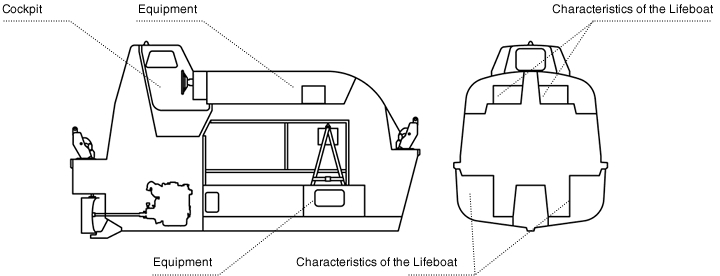- Solution
- Technology
- Our Feature
-
Inspection and
Repair Services -
Product Introduction
- Our Message
- Management Concept
- Company Outline
- Contact us

These are lifesaving devices on which crews can escape safely from the mother ship in emergencies, such as wrecks at sea (hull abandonment), or when performing rescue operations. The number of staff which can board one lifeboat is equal to that of the capacity of the mother ship.
In consideration of a single board slant of the mother ship, there are two kinds of mother ship loading methods of our lifeboats: either port and starboard or on the stern.
Our free fall lifeboat is carried on the stern, and our Totally Enclosed Lifeboats or Fire-Resistanct Lifeboats are carried once each either port or starboard.
For free fall lifeboats a rescue boat is carried on the stern.
 The outer and inner shells are manufactured by a product made from FRP (tempered fiberglass and reinforced plastic by fire-retardant resin), and our lifeboats excel in intensity,
anticorrosion, and light resistance. Furthermore, foaming urethane between the outer and inner shells, our lifeboats are offer better shock resistance, buoyancy, and insulation.
The outer and inner shells are manufactured by a product made from FRP (tempered fiberglass and reinforced plastic by fire-retardant resin), and our lifeboats excel in intensity,
anticorrosion, and light resistance. Furthermore, foaming urethane between the outer and inner shells, our lifeboats are offer better shock resistance, buoyancy, and insulation.
Our lifeboats are designed considering the safety
of human life first, shock-resistance, buoyancy, stability, resistance to fire and corrosion, and light.
In addition, prompt hull abandonment in case of emergencies such as shipwreck is enabled thanks to our simplified manual.
Moreover, the main engine of the lifeboat is a water-cooled diesel engine, and can cruise at 6 knots/h for 24 hours.
In addition, our lifeboats can be equipped with amenities such as food and drinking water for three days per
person.
